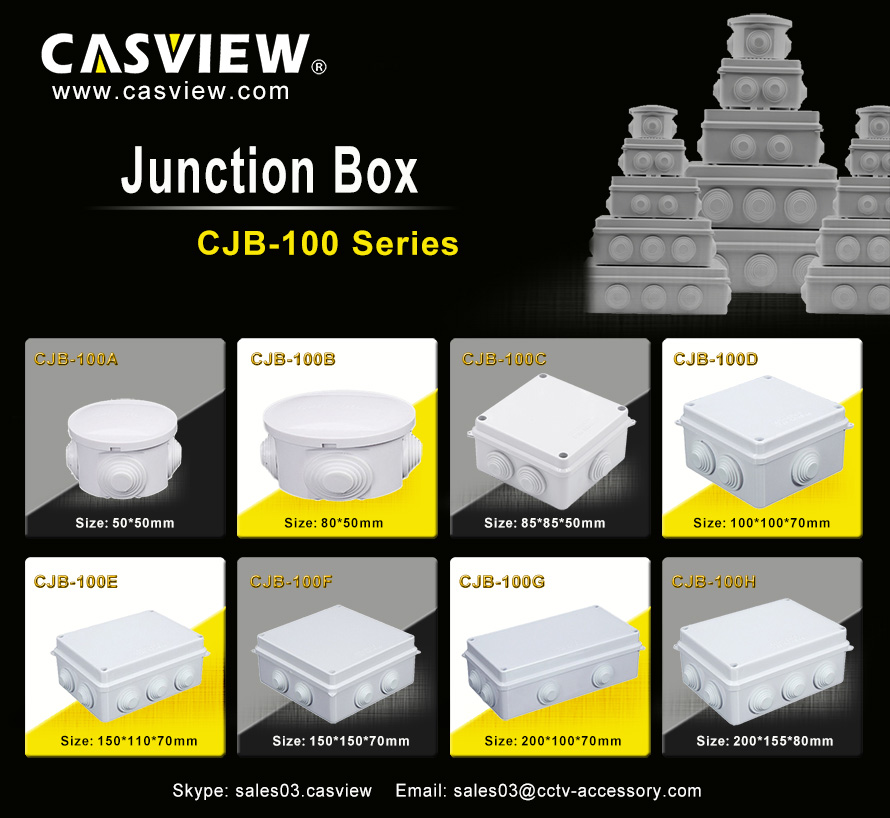Analog CCTV Technical FAQ
Understanding Junction Box Types and Applications
Junction Box, a key component of an electrical system, is a protective box that houses electrical connections. Understanding types of junction boxes and uses can help homeowners, electricians, and other do-it-yourself enthusiasts make decisions about electrical projects.
What is a junction box?
A junction box is an enclosure that holds electrical connections. A junction box protects the wires from injury and provides a safe area to splice wires. A junction box is an important element of the electrical system. They help prevent electrical fires and keep your electrical work safe. Junction boxes are offered in many shapes, sizes, and materials for unique installation situations and to meet different needs.

Types of Junction Boxes
1. Plastic Junction Boxes Material: PVC or other plastic materials. Use: Commonly used in residential wiring due to their lightweight and corrosion-resistant properties. Application: Indoor applications but NOT in moisture concerns. Easy to use and come in various sizes depending on wire(s).
2. Metal Junction Boxes Material: Steel or aluminum. Use: Very durable and performs better against impact and environmental factors. Application: Different than plastic boxes, these would be for commercial or industrial settings. Metal boxes can provide better grounding for electrical systems for outdoor applications that are exposed to harsher conditions.
3. Weatherproof Junction Boxes Material: Heavy duty plastic or metal with seals. Design to withstand moisture and environmental issues. Application: Outdoor, damp locations such as basements or in bathrooms for safest.
4. Fiber Junction Boxes Material: Fiberglass or other materials. Use: Also lightweight and resistant to corrosion and chemicals. Application: Commonly used in industrial contexts where hazardous levels of chemicals is possible. For example, in factories or labs.
5. Ceiling Junction Boxes. Material: Can be plastic or metal. Use: Is specifically designed to attach fixtures, such as lights or fans to the building. Application: This type is used in the ceiling where it serves to help keep fixtures positioned correctly while ensuring safety.
6. Low-Voltage Junction Boxes. Material: Commonly plastic. Use: Created for low voltage applications, such as data or telecommunications wiring. Application: Best for home networking, security systems, or audio/visual since high voltage is negligible.
7. Gang Boxes.
Material: Made of plastic or metal?
Use: Made to hold numerous switches, outlets, or connections in one area. Application: Common in walls to manage several different electrical devices in an aesthetically pleasing manner.
Choosing Junction Box Types
When selecting junction boxes, you should take the following into consideration:
Application: Is the junction box being installed by a home or in an outdoor space, does the junction box need to handle moisture, or hazardous chemical attack?
Material: Plastic, metal, or fiberglass based on the environment and damage durability.
Size: Do you have room enough in the junction box for all of the wires and connections without crowding?
Local Codes: Do you need to check with local building codes to see if there are any special requirements for a junction box?
Conclusion
Junction boxes are instrumental in ensuring safety and safely functioning. Understanding the varied types of junction box and the situations in which each is used can lead to better decisions about your electrical work. Whether you are a homeowner and wiring, or an electrician and doing a commercial project, choosing an appropriate junction box is important in ensuring safety and code compliance, and ultimately avoiding accidents.
Categories
Contact Us
Contact: Sales Departmment
Phone: 0086-13509605206
Tel: 0086-755-2919 5509
Email: sales03@cctv-accessory.com
Whatsapp: 86-13509605206
Add: 4F, B Building, Lanshang Pioneering Park, Xinfeng Rd, Longgang District, Shenzhen, China
 Casview sales
Casview sales Casview Sales
Casview Sales 86-13509605206
86-13509605206